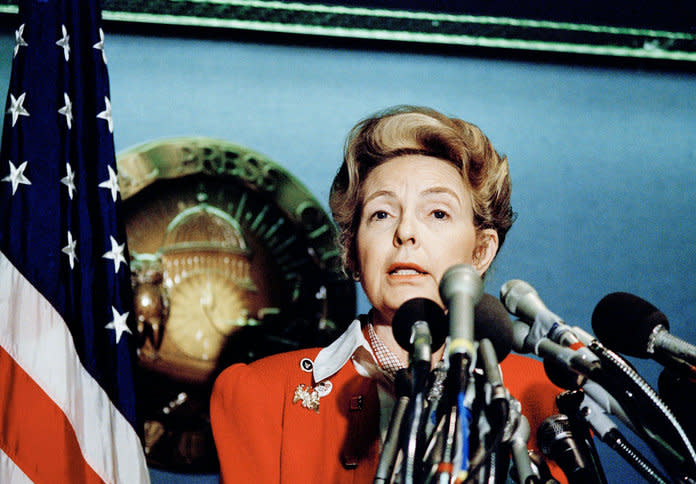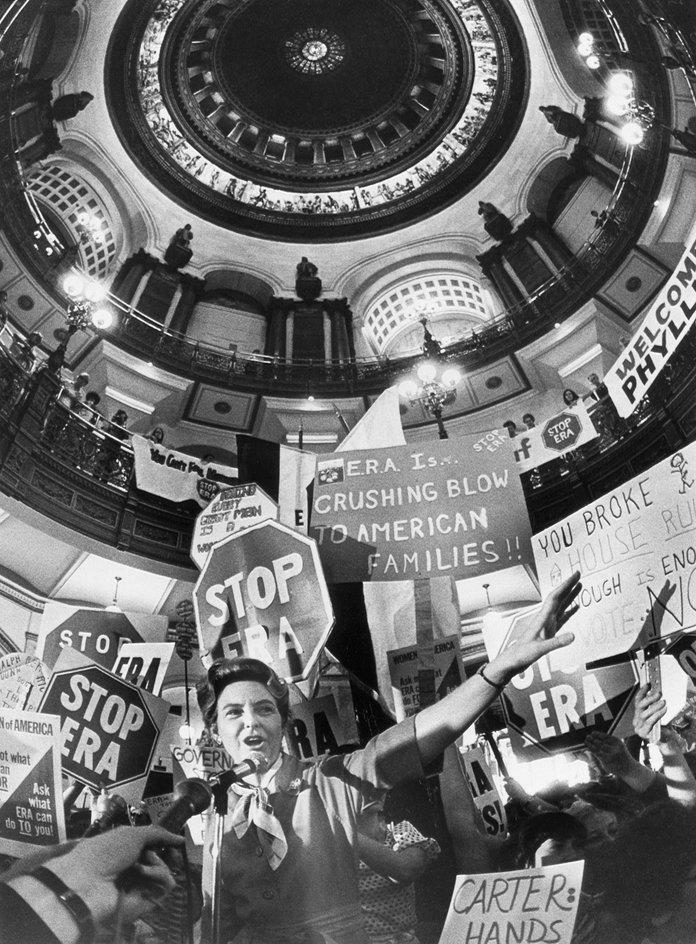Who Was the Anti-ERA Activist Phyllis Schlafly?
The trailer for Mrs. America has landed, with Cate Blanchett front-and-center as an icy Phyllis Schlafly. The FX limited series is based on the real story of the Equal Rights Amendment and its long road toward ratification, with Schlafly as its ripped-from-the-headlines antagonist. Called the “first lady of the conservative movement,” Schlafly, who passed away in 2016, was a housewife-turned-activist who, despite not holding formal political office, championed conservative causes, including campaigning hard against the ERA, which would’ve expanded women’s rights by not allowing gender-based distinctions in federal and state laws.
Despite saying “women find their greatest fulfillment at home with their family,” Schlafly spent time working in politics, or politics-adjacent fields. This included having a bachelor’s degree in political science and a master’s in government, and, after working at a conservative think tank, Schlafly returned to her home in St. Louis to work on the congressional campaign of republican Claude Bakewell, and following that, worked as a librarian and at a bank. But marrying her husband, John Schlafly, Jr., was one of Schlafly’s entry points to politics: According to reporting from The New York Times, in 1952, Schlafly’s husband turned down Republicans who wanted him to run for Congress. Schlafly offered to run in his place, winning the primary but losing in the general election.
Following that experience, Schlafly was president of the Illinois Federation of Republican Women from 1956 to 1964. She used media platforms to her advantage: As a devout supporter of Senator Barry Goldwater’s failed presidential campaign, she published a pocket-sized book advocating for his candidacy, A Choice Not an Echo, which sold over three million copies. In 1962, she hosted a national security radio show called “America Wake Up.” She had multiple political losses, including a 1967 loss for president of the National Federation of Republican Women, and a 1970 run for Congress. Her biggest win, just now unraveled in 2020, was successfully blocking the ERA.
RELATED: How Nancy Pelosi Went From "Basically Shy" to Basically Running D.C.
Appearing alongside Blanchett as her foils are Rose Byrne bespectacled as Gloria Steinem and Uzo Aduba as congresswoman Shirley Chisholm. They paint the contrast between the women’s liberation movement of the '60s and '70s and Schlafly’s argument that feminism isn’t about “advance and success for women,” but about “power for the female left.” (The trailer paraphrases this quote, when Blanchett says via voiceover: “This fight is not about equality. It’s about power.”) As the story goes, Phyllis Schlafly ignited a grassroots conservative movement by focusing on the “rights of the wife,” and claiming the ERA promoted abortions and homosexuality, and denied women the right to be supported by their husbands. “We want the right to be a mother, the right to be a wife,” Blanchett as Schlafly says in the trailer, another paraphrase of an actual Schlafly quote, “a woman should have the right to be in the home as a wife and mother,” (said to Newswek in 1977). Of course, we now know the ERA would codify gender equality, including in terms of pregnancy discrimination protections, equal pay, and protections for victims of gender-based violence, and there’s nothing in it that would strip rights away from any group (except, perhaps, corporations that still get away with paying women less than men and other forms of gender-based discrimination.)
Schlafly harnessed the fear of women’s liberation and turned it into a “political force in the Republican party,” says Tanya Melich’s 1996 book, The Republican War on Women. It’s a political force that’s still present today, with continued battles for women’s rights to their own bodies. But as of Wednesday, January 15th, 2020, Virginia shattered Schlafly’s biggest win: It became the 38th state to ratify the ERA, in a historic victory for the decades-long battle for gender equality.

Barry Thumma/AP/Shutterstock
Though Schafly might be most popularly known for successfully derailing the ERA, her presence in American politics fundamentally altered our political landscape. As Blanchett takes her persona to the small screen, it’s worth a look back at who she was, and how she has impacted our politics and lives to this day.
Anti-abortion activism
Schlafly was an outspoken anti-abortion advocate. Once upon a time, according to reporting by Vox, the Republican party saw women’s equality issues differently: First Lady Betty Ford spoke up for abortion rights and defended Roe V. Wade, including during a 1975 60 Minutes interview, where she said, "I feel very strongly that it was the best thing in the world when the Supreme Court voted to legalize abortion.” The party supported the ERA. Enter Schlafly, who wrote the GOP’s anti-abortion platform that eliminated all references to “exceptions” in 1996, after she co-chaired Pat Bunchanan’s 1996 presidential campaign, and his anti-abortion stance called for new wording. Even now, Schafly’s organizations, Phyllis Schlafly Eagles (which says in its “About” section that it “exposes the radical feminists”) and Eagle Forum, continue to take stands against abortion and feminism.
Halting the ERA
Schlafly’s STOP ERA campaign began as a monthly newsletter, outlining what she believed would be the collapse of society, including the ERA demanding “homosexual marriage,” unisex bathrooms, and drafting women into serving in the army. (It’s important to note that all of these things have come to pass after social pressure, and voter demand.) She organized “volunteer brigades” comprised of mostly conservative, middle-class white women, and attended 41 state hearings in order to testify against the Equal Rights Amendment. At the time, she told The New York Times “I simply didn’t believe we needed a constitutional amendment to protect women’s rights.”
Dismantling the ERA tied into Schlafly’s anti-gay agenda, too, because, according to reporting by Slate, it “allowed her to bring together a variety of groups that were united in their opposition to homosexuality,” and she continuously opposed same-sex relationships and marriage (despite having a son who came out as gay in 1992).

Bettman/Getty Images
The ERA was proposed to Congress every year between 1923 and 1970, though the only time it ever made it to the floor for a vote was 1946. Meanwhile, organizations like the National Organization for Women, had an agenda (with a statement of purpose written by Betty Friedan, portrayed in the series by Tracey Ullman) to make “women’s participation in all aspects of American life,” which included passing ERA. The ERA had already passed Congress by the time Schlafly launched her campaign, but it officially died in 1982, when the amendment only received ratification from 35 states instead of the 38 states required. Unfortunately, for women’s rights, Schlafly’s victory stood the test of time, until a blue wave hit Virginia in 2019 and those lawmakers voted to ratify it, as promised, right away in 2020.
RELATED: It's Happening — Virginia Votes to Ratify the ERA, 74 Years Later
Opposing school desegregation
Beyond opposing the women’s rights agenda, in 1960, Schlafly ran a platform opposing desegregation, according to reporting from the Intelligencer. That included opposing an anti-racism plank supported by Richard Nixon at the 1960 Republican National Convention. According to reporting by Deadspin, Schlafly also repurposed phrasing from her anti-ERA campaign to fuel desegregation work: “Do you want the sexes fully integrated like the races?” it asked. As Laura Briggs, Professor of Women and Gender Studies at the University of Massachusetts Amherst, wrote for Public Seminar in 2019: “Phyllis Schlafly and others like her organized to make the Republican Party hostile to feminists and anti-racists.”
In 2007 at the age of 83, Schlafly announced during a student talk at Bates College that “by getting married, the woman has consented to sex, and I don’t think you can call it rape.” She also supported President Donald Trump in 2016. As Schlafly’s presence whirls back into the public eye, it’s worth noting that most of what Schlafly spent her life rallying against has come to pass, including, finally, the Equal Rights Amendment she so vehemently opposed.

